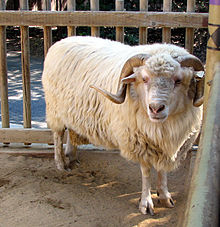Navajo-Churro sheep

A Navajo-Churro ram
|
|
| Conservation status | Threatened |
|---|---|
| Other names | American Four-Horned Sheep, Navajo Four-Horned Sheep |
| Country of origin | United States |
| Traits | |
| Weight |
|
| Wool color | W Color |
| Face color | F Color |
| Notes | |
| Extra notes | |
|
|
The Navajo-Churro, or Churro for short, (also American or Navajo Four-Horned) is a breed of domestic sheep originating with the Spanish Churra sheep obtained by Navajo, Hopi and other Native American nations around the 16th century during the Spanish Conquest. The breed is renowned for its hardiness and adaptability to extremes of climate. Its wool consists of a protective topcoat and soft undercoat. Some rams have four fully developed horns, a trait shared with few other breeds in the world. The Navajo-Churro has also gained popularity for its low-maintenance reputation, resistance to disease, and lean meat. Some say they are very personable. Ewes often birth twins. This breed is raised primarily for wool.
Navajo-Churro are descended from a cross between the Churra and the Jacob Sheep. The Churra (renamed Churro by American frontiersmen) was first imported to North America in the 16th century and used to feed Spanish armies and settlers. By the 17th century Churros were popular with the Spanish settlers in the upper Rio Grande Valley. Flocks of Churros were also acquired by the Navajo through trading. The Churro soon became an important part of the Navajo economy and culture.
A series of United States government-sponsored flock reductions and cross-breedings decimated the Navajo flocks until the Churro sheep nearly disappeared. Restoration of the breed began in the 1970s when breeders began acquiring Churro phenotypes with the purpose of preserving the breed and revitalizing Navajo and Hispanic flocks.
While the Navajo-Churro breed is no longer in danger of extinction, Navajo-Churro sheep are still considered a rare breed.
...
Wikipedia
